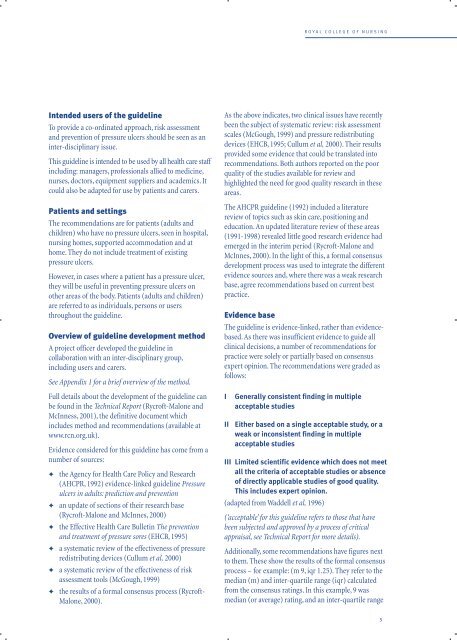Ulcer Guidelines extent - Judy Waterlow
Ulcer Guidelines extent - Judy Waterlow
Ulcer Guidelines extent - Judy Waterlow
Create successful ePaper yourself
Turn your PDF publications into a flip-book with our unique Google optimized e-Paper software.
ROYAL<br />
COLLEGE OF NURSING<br />
Intended users of the guideline<br />
To provide a co-ordinated approach, risk assessment<br />
and prevention of pressure ulcers should be seen as an<br />
inter-disciplinary issue.<br />
This guideline is intended to be used by all health care staff<br />
including: managers, professionals allied to medicine,<br />
nurses, doctors, equipment suppliers and academics. It<br />
could also be adapted for use by patients and carers.<br />
Patients and settings<br />
The recommendations are for patients (adults and<br />
children) who have no pressure ulcers, seen in hospital,<br />
nursing homes, supported accommodation and at<br />
home. They do not include treatment of existing<br />
pressure ulcers.<br />
However, in cases where a patient has a pressure ulcer,<br />
they will be useful in preventing pressure ulcers on<br />
other areas of the body. Patients (adults and children)<br />
are referred to as individuals, persons or users<br />
throughout the guideline.<br />
Overview of guideline development method<br />
A project officer developed the guideline in<br />
collaboration with an inter-disciplinary group,<br />
including users and carers.<br />
See Appendix 1 for a brief overview of the method.<br />
Full details about the development of the guideline can<br />
be found in the Technical Report (Rycroft-Malone and<br />
McInness, 2001), the definitive document which<br />
includes method and recommendations (available at<br />
www.rcn.org.uk).<br />
Evidence considered for this guideline has come from a<br />
number of sources:<br />
✦<br />
✦<br />
✦<br />
✦<br />
✦<br />
✦<br />
the Agency for Health Care Policy and Research<br />
(AHCPR, 1992) evidence-linked guideline Pressure<br />
ulcers in adults: prediction and prevention<br />
an update of sections of their research base<br />
(Rycroft-Malone and McInnes, 2000)<br />
the Effective Health Care Bulletin The prevention<br />
and treatment of pressure sores (EHCB, 1995)<br />
a systematic review of the effectiveness of pressure<br />
redistributing devices (Cullum et al, 2000)<br />
a systematic review of the effectiveness of risk<br />
assessment tools (McGough, 1999)<br />
the results of a formal consensus process (Rycroft-<br />
Malone, 2000).<br />
As the above indicates, two clinical issues have recently<br />
been the subject of systematic review: risk assessment<br />
scales (McGough, 1999) and pressure redistributing<br />
devices (EHCB, 1995; Cullum et al, 2000). Their results<br />
provided some evidence that could be translated into<br />
recommendations. Both authors reported on the poor<br />
quality of the studies available for review and<br />
highlighted the need for good quality research in these<br />
areas.<br />
The AHCPR guideline (1992) included a literature<br />
review of topics such as skin care, positioning and<br />
education. An updated literature review of these areas<br />
(1991-1998) revealed little good research evidence had<br />
emerged in the interim period (Rycroft-Malone and<br />
McInnes, 2000). In the light of this, a formal consensus<br />
development process was used to integrate the different<br />
evidence sources and, where there was a weak research<br />
base, agree recommendations based on current best<br />
practice.<br />
Evidence base<br />
The guideline is evidence-linked, rather than evidencebased.<br />
As there was insufficient evidence to guide all<br />
clinical decisions, a number of recommendations for<br />
practice were solely or partially based on consensus<br />
expert opinion. The recommendations were graded as<br />
follows:<br />
I<br />
II<br />
Generally consistent finding in multiple<br />
acceptable studies<br />
Either based on a single acceptable study, or a<br />
weak or inconsistent finding in multiple<br />
acceptable studies<br />
III Limited scientific evidence which does not meet<br />
all the criteria of acceptable studies or absence<br />
of directly applicable studies of good quality.<br />
This includes expert opinion.<br />
(adapted from Waddell et al, 1996)<br />
(‘acceptable’ for this guideline refers to those that have<br />
been subjected and approved by a process of critical<br />
appraisal, see Technical Report for more details).<br />
Additionally, some recommendations have figures next<br />
to them. These show the results of the formal consensus<br />
process – for example: (m 9, iqr 1.25). They refer to the<br />
median (m) and inter-quartile range (iqr) calculated<br />
from the consensus ratings. In this example, 9 was<br />
median (or average) rating, and an inter-quartile range<br />
5


